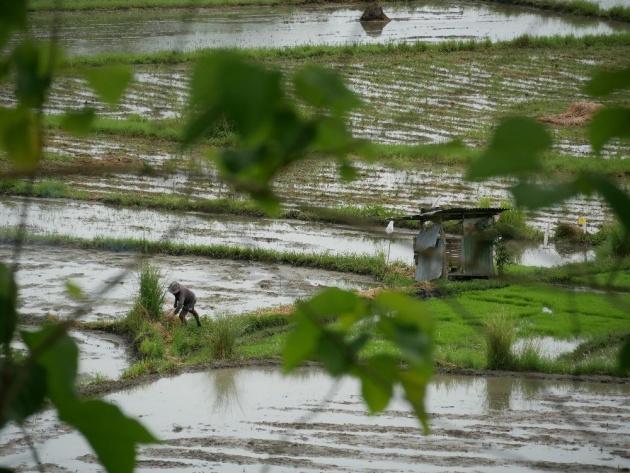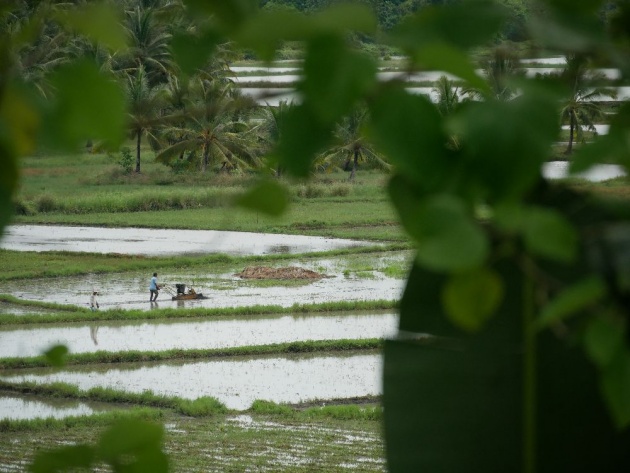Image credits: letstalkagric.com
Rice - the staple food of the Filipinos and most Asians. It is characterized by these elongated yet short white pieces of grains and is cooked by adding water over heat either with fire or through a more advanced electric cooker.
But before these are served hot on our tables, it goes through a long process. I had realized that it isn't easy to grow rice so each single grain indeed deserves to be preserved and saved as much as possible.
Today morning while silently observing the view of the rice fields, the coconut trees from afar and a partly bald mountain due to a recently concluded gold digging activity, I noticed the tiny pieces of moving human bodies bent forward and are reaching the surrounded muddy fields while implanting the tiny pieces of rice plants. It is the rainy season and it also means the start of the planting season.
As I was just hanging my towel after taking a bath, the rain started pouring and I spotted the rice farmers running towards the land. I figured out the waters on the rice fields was significantly increasing because of the strong rain plus there were strong winds to add to their agony. It seems they had been ignoring the rain for some time but after a few more minutes, the water has increased and a sign of flooding is evident. They immediately ran for their lives but considering the muddy path given that there is rain and winds, their running slowed down even more.
Video credits: Jean Beltran-Figues via bitLanders.com
But after some time, they were able to get out from the field and found a place for shade. I wonder if there was even one dry part of their bodies after that scenario, I believe there's none.
So after seeing that movie worthy scene, I realized the struggle and the perseverance each farmer has to endure just so each of us has rice on hand for breakfast, lunch and dinner even snacks for Filipinos deserve a plate of rice on the table. Today, let me tackle on the process of how farmers produce rice from scratch to that in our tables.
Planting Rice is not a Joke
The process start with the previous harvest's few cups of grains left in the muddy field to grow into sprouts of rice plant. After a few weeks of waiting, the plants are being prepared and while waiting for it to grow a few mire inches to become a seedling of an estimate of around 8 inches should be good, the rice field is also prepped as follows:
1. Cleaning the Fields

A farmer cleaning the sides of the field. Photo credits: Jean Beltran-Figues via bitLanders.com
This requires effort of clearing the field out of anything that could possibly become a competitor of the nutrients that the rice plants would get from the soil. Clearing the soil from any live snails or insects is also part of the process.
2. Plowing the Fields

Spotted at the back of our house is this farmer plowing his field. Photo credits: Jean Beltran-Figues via bitLanders.com
The plowing process has a traditional way of making use of the Carabao's help. Carabao or the Water Buffalo is a strong animal which has been considered as the farmer's best friend before all the machinery came into life, the farmer has been dependent on the carabao to pull the material used in plowing the field. In today's generation of machines and technology, a machine referred as turtle is now introduced to the farmers so they can be more efficient in plowing the fields. The machine saves time and energy both for the farmer and the animal, however, it is still very costly so there are still other farmers who are keeping their best friend's company in the field.
3. Planting the Seedlings
The most tiring part of them all. This requires three or more farmers to work on the land. I recall a grade school Tagalog song which says :
"Magtanim ay di biro
maghapong nakayuko.
Di naman makatayo
di naman makaupo."
In English, it states planting rice is not a joke, a whole day of bending where he or she is not able to stand up nor sit down. Here's a video of local Filipino farmers planting and singing this specific song:
Video credits: Sanny Tendilla via YouTube.com
Fertilizing the Rice Plants
After getting the seedlings planted aligned and straight, the farmers are off to buy fertilizers. Depending on the variety of rice, it will grow in approximately three to four months and this will require utmost care from insects, birds, pests and other elements which might affect the growth of the rice plants.
A farmer ready for spraying fertilizers. Photo credits: http://musingcarabao.blogspot.com
Prevention is better than cure so it is indeed needed that the farmers would clear out the way for their plants to grow healthy and fast. One way of doing so is by applying fertilizers.
Except you are planning to grow organic rice like the farmers at the Batad Rice Terraces, a farmer is obliged to apply fertilizers. They are mixing the fertilizer solution into a container and they'll be spraying these to the newly planted plants.
In certain cases when there are pests starting to eat up the plants, farmers will have to add few more solutions which will kill the insects or pests but should be safe for human consumption.
Irrigation and Water
Another basic need and requirement in having rice fields is the irrigation. Irrigation is referred as the watering system of the field. Most rice fields have irrigation system coming from natural springs while others have artificial wells and pumps that supplies the water from the bottom of the land.
Since rice is grown two to three times a year in the country, proper irrigation system is very necessary for the success of the rice planting. The government has also made actions to help the farmers through the efforts and help of the Department of Agriculture Secretary, Sec. Manny Piñol.
One of their programs is to provide free irrigation systems to farmers through the use of solar powered water pumps which enables easy and cheap supply of water specially during the dry season.
Harvesting
The harvest along the dry grounds of the paddy field. Photo credits: musingcarabao.blogspot.com
Waiting time is three to four months and the green leaves and rice grains are starting to fall and turn yellow. Slightly bent stalks containing rice grains signify that these are ready for harvest.
The farmers would thank the heavens if this scenario can be seen and that no famine or tragedy or pests had ruined the hard work of their labor. They will soon prepare for man power and additional help from families or friends for the harvest. This process requires a few steps as follows:
1. Harvest Cutting
This is the bolo used for cutting the stalks of rice plants. Photo credits: musingcarabao.blogspot.com
A number of helpers or perhaps farmers will be using a special kind of bolo used for cutting the stalks, it has a curved edges and definitely sharp. While other countries show their advance technology in terms of rice harvesting, in the country, the traditional way is still observed. One, two or more farmers are assigned to cut down these plants.
2. Harvest Mobility
As the other sets of farmers cut them down, some are designated to bring collect and carry these harvest to a specific spot in the rice field where a machine is waiting to separate the grains from the stalk and leaves. These farmers are usually wearing something that can cover him from head to toe as the dried rice plant leaves and stalks has the tendency of itching or developing allergy to someone. It is therefore better to keep the skin away from it.
3. Separation of stalk and grains
Farmers using a machine to separate the grains from the plant. Photo credits: musingcarabao.blogspot.com
At this point of time, a machine is needed to separate the grains from the stalk and leaves. The use of a miller and blower is appreciated by the farmers as they wait for the fruits of their labor being spitted out of the mouth of the miller. The blower's use is for the remaining little particles to separate from the grains. Those staffs as well will be eliminated. Also after doing so, the grains are contained into sacks.
Drying of Grains
A farmer raking the grains for drying. Photo credits: musingcarabao.blogspot.com
All the harvests on land for drying. Photo credits: musingcarabao.blogspot.com
After all the processes, the efforts of being a farmer has not yet ended. Drying of grains is another step necessary for them to sell their harvest. Grains are sun dried for a couple of days and will be exposed to stealing.
Most Filipino farmers dry their harvest along the road, just above the cemented road as the cement underneath helps the rice easily gets dry. Constant racking of grains is also done to ensure that all the pieces are perfectly dry. Then they'll put them all again in a sack and will be sent for milling.
Milling
Finally the last step is for the grains to be milled to get rid of their covering so the pure rice pieces will be ready for selling to distributors or perhaps farmers will also be milling it for their own consumption.
Lastly, milling the dried up grains for stocking or reselling. Photo credits: musingcarabao.blogspot.com
Unfortunately, the farmers will be paying a few bucks to pay for the milling service. This would depend on the number of sacks. Then after which they'll be selling the sacks of rice to either the local consumers or they'll import it towards other towns and provinces.
I had relearned the process of planting rice and its other components because of the scene I had today. This didn't only show that I have this eagerness to help our farmers. We are truly thankful that they are there to provide us with rice in our plates. They deserved to be thanked indeed.
Most diets would encourage to stop eating rice because of its carbohydrate content. Please participate on the Querlo below:
Hope you enjoyed the blog. Take care!
Jean Beltran-Figues




